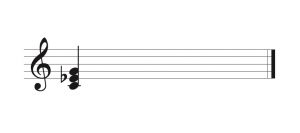10 The Major and Minor Triad
A triad is a three-note chord commonly found in many different styles of music. The major triad consists of the first, third, and fifth notes of the major scale and can be played melodically (one note at a time) or harmonically (all three notes simultaneously). (More information on triads can be found in Chapter 21 of an Introduction for Music Theory and Rudiments.)


The audio examples in this course will always play triads both melodically and harmonically.
While we cannot sing three notes all at once, it is possible to sing/hum a triad melodically. When singing or humming a major triad, it is possible to focus on the intervals between the first (1st) and second (3rd), and second (3rd) and third note (5th), or to focus on the triad holistically—either method works; it is just personal preference.
Try humming/singing the major triad melodically, using numbers if possible (1, 3, 5). Use the Record button below to compare and evaluate.
A minor triad sounds very similar to a major triad, which makes sense as there is only one note different. Changing a major triad to a minor triad only requires lowering the 3rd of the chord (middle note) down by one semitone.


Try humming/singing the minor triad melodically, using numbers if possible (1,3,5). Use the Record button below to compare and evaluate.
Listen to the differences between the major and the minor triad. What do you observe? Aurally, the major triad is often associated with a sense of happiness, whereas the minor triad can invoke a sense of sadness. Is this how they sound to you? Both are used extensively in modern music, which can sometimes alter our perceptions of the sounds. Major triads can be used in sad songs, and minor triads can also be used in happy songs. Focusing on humming/singing them in isolation can help inform how we hear them in the context of a song or piece of music.

